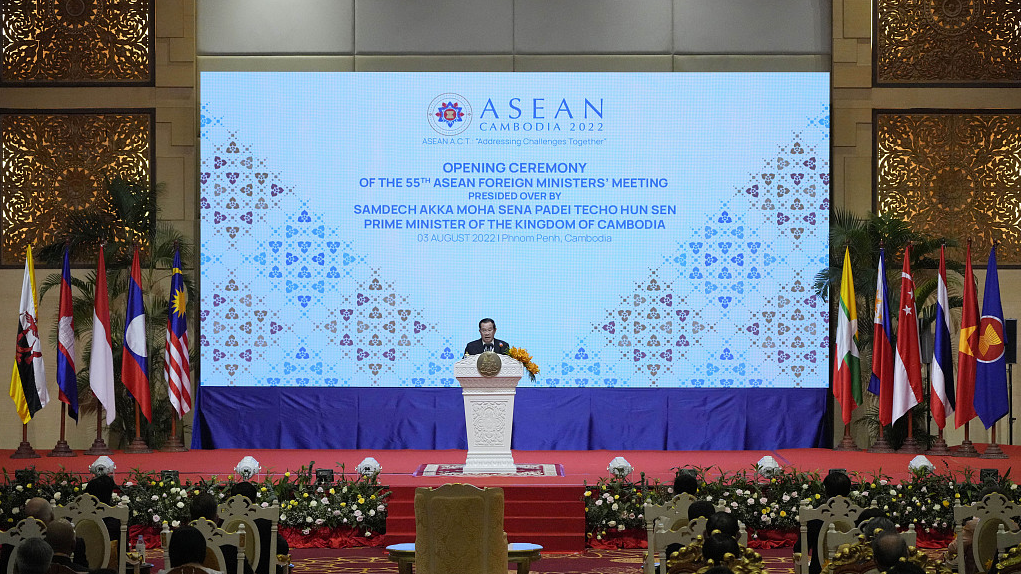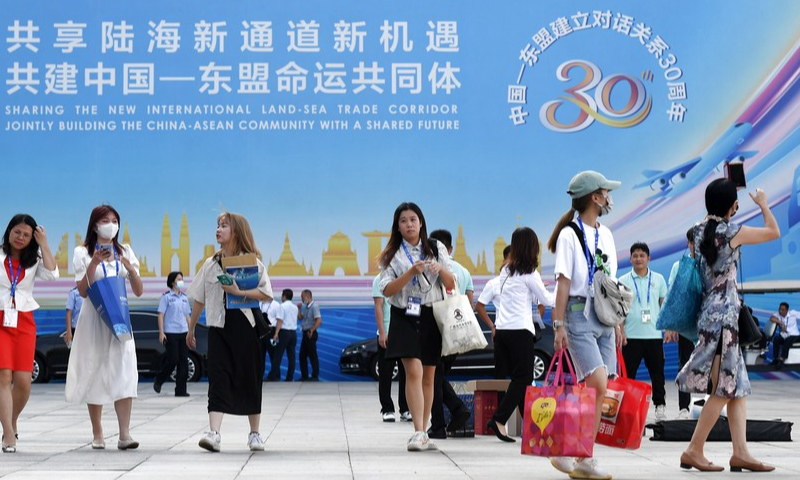
Cambodian Prime Minister Hun Sen delivers the opening speech for the 55th ASEAN Foreign Ministers' Meeting (55th AMM) at a hotel in Phnom Penh, Cambodia, Wednesday, August 3, 2022. /CFP
Cambodian Prime Minister Hun Sen delivers the opening speech for the 55th ASEAN Foreign Ministers' Meeting (55th AMM) at a hotel in Phnom Penh, Cambodia, Wednesday, August 3, 2022. /CFP
Editor's note: Hamzah Rifaat Hussain, a former visiting fellow at the Stimson Center in Washington and former assistant researcher at the Islamabad Policy Research Institute, is a TV anchor at Indus News in Pakistan. The article reflects the author's opinions and not necessarily those of CGTN.
At the 29th ASEAN Regional Forum (ARF) in Cambodia, ASEAN member states along with South Korea, China and Japan (10+3 states) issued a forum statement. The statement affirmed a commitment to upholding international law, fostering constructive dialogue and cooperation while enhancing efforts to combat poverty and social inequities.
Chinese Foreign Minister Wang Yi's four proposals at the forum provide a framework for the region to achieve its economic potential and contribute to joint prosperity in the face of challenges, unipolarity and economic downturns.
The future of East Asia in 2022 lies in peaceful development and regional connectivity. This consensus is important as the region's tremendous economic potential can achieve greater heights in the absence of hostilities through concrete frameworks which can usher in peace, security and confidence building measures towards joint prosperity.
The timing of the forum coincided with East Asia finding itself threatened by hegemonic designs from the United States which seeks to divide the region along ideological lines. Hence, it is imperative that the region upholds principles enshrined in the UN Charter as well as the Treaty of Amity and Cooperation in South East Asia (TAC) which was established in 1976.
The treaty seeks to promote peaceful coexistence and friendly cooperation between all states in the region and in 2022, Wang Yi's four proposals at the ARF provide additional frameworks through which states from Laos to Singapore can jointly work towards economic prosperity.
The theme of the 2022 meet in Cambodia for example, deals with addressing challenges collectively and developing consensus on achievable economic goals. The first proposal, planning a blueprint for East Asia's long-term development, upholds the essence of multilateralism where 10+3 states can deepen meaningful cooperation by developing a five year work plan.
This allows member states to outline achievable goals, monitor progress and take effective domestic measures to readdress shortcomings on generating human capital or enhancing GDP growth rates. Note how regional countries in East Asia have varying governance systems, different stages of economic development and a diverse set of challenges. A five-year plan allows each state to work on a set framework to build linkages and promote regional economic integration.

People walk out of the venue of the 18th China-ASEAN Expo in Nanning, capital of south China's Guangxi Zhuang Autonomous Region, September 11, 2021. /Xinhua
People walk out of the venue of the 18th China-ASEAN Expo in Nanning, capital of south China's Guangxi Zhuang Autonomous Region, September 11, 2021. /Xinhua
ASEAN states are also members of trade agreements such as the Regional Comprehensive Economic Partnership (RCEP) which continues to be the world's largest trade agreement by volume. The second proposal put forth by Wang Yi ensures that member states can harness existing potential and capitalize on this arrangement in 2022 within the framework of the joint ASEAN-China Cooperation Fund. Through joint financing, East Asian states can ward off supply chain shocks with the integrative development of regional industrial and supply chains so as to address economic downturns.
Furthermore, disputes within the region must also be resolved indigenously with solutions centering on strengthening the rule of law, providing adequate access to justice and promoting transparency. The third proposal on crisis management is critical for states facing untoward situations such as loss of human capital due to the COVID-19 pandemic. In such cases, equitable access to health care facilities constitutes a joint responsibility for member states to ensure greater social justice.
For far too long upholding the essence of international law in the region has been threatened due to external interference, unilateralism, protectionism and transactional dealings from the U.S. which has dented Washington's credibility in East Asia. Geopolitical strategies seeking to divide the region into camps must be replaced with dialogue, deliberation and joint understandings on poverty eradication and sustainable development to usher in a brighter and more resilient future for regional states.
In an age of digitization and transformation, it is equally important for 10+3 states to promote digital technologies and e-commerce which can facilitate stronger trading ties between all states. As one of the main engines of global economic growth, East Asia can greatly enhance its current infrastructure and push to address development gaps in the region which become exaggerated due to lack of digital growth. Speedy development of technologies can also facilitate green development, lower carbon emissions and energy sufficiency.
It is clear that the ARF can produce solid recommendations to guide regional economies forward. Collective prosperity can definitely be realized through implementation.
(If you want to contribute and have specific expertise, please contact us at opinions@cgtn.com. Follow @thouse_opinions on Twitter to discover the latest commentaries in the CGTN Opinion Section.)

